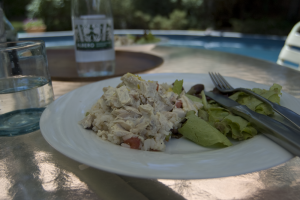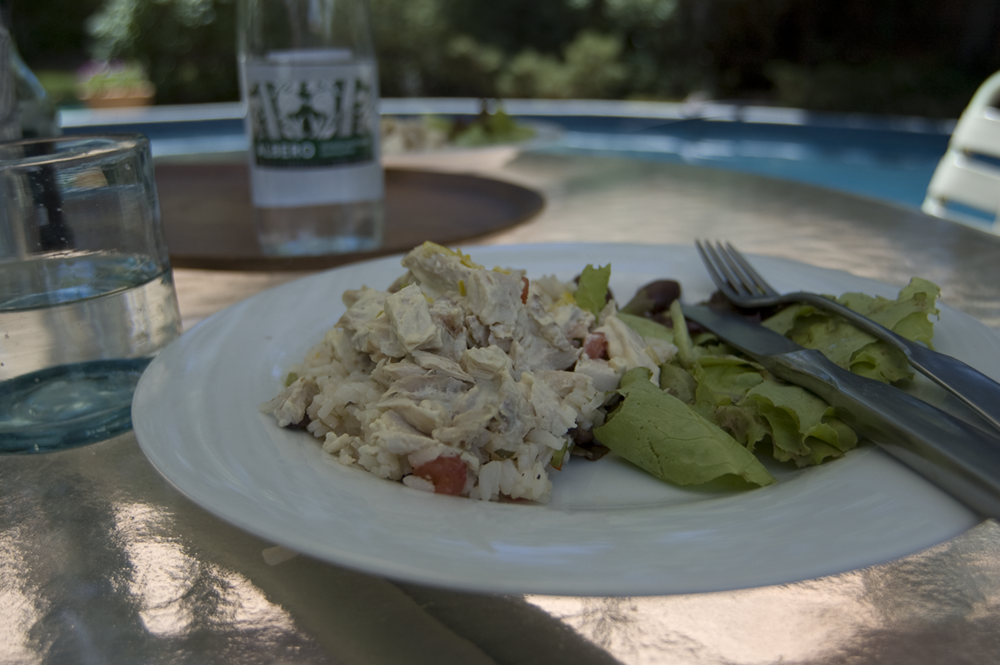Chicken better than any chicken salad.

That’s what Elizabeth David promised with this recipe in her Mediterranean Cooking. The result … lunch by the pool, a setting as secluded as a honeymoon suite, delivered effortlessly by the perfect lover.
The recipe will follow, and so will the ideal rice salad to serve with it, as per Ms. David’s cookbook. But first, let’s start with how to make summer food prep easy … and end with the sublime delivery of Chicken Veronique.
One: Roast a whole chicken, on the coolest night you’ve got, or one when you can sit outside and read a good book. Start the oven at 425 degrees F. Rub chicken with a butter paper if you intend to eat any skin. Cut a lemon in two, rub the outside of the chicken with it, toss the lemon parts inside (remove gizzard, etc.), add a cup of white wine and roast breast-side up in a LeCreuset or similar (can there be a similar?) casserole, covered. Turn the oven down to 350 after 15 minutes. In less than 1/2 hour the chicken breast should be done — reached a mere 150-155 degrees. Use an instant read thermometer, or better yet, one that calls you when it gets to temperature. See, this is easy, and doesn’t heat up the house too long. But, do leave the oven on for a few more minutes.
The breast will be tonight’s dinner, and the leg & thigh I’ll use for the Chicken Veronique. So, I cut off the wings, then the leg and thigh as one unit each and cut the breast from the back. I cut the breast in two and put these on plates — dinner for two, or maybe here I reserve a little for chicken enchiladas. If my kids were going to be at home, I’d make this go four ways. If I want a sauce, I take out a cup of juice from the casserole and add a thickener and flavors. (1 egg yolk and a few spoonfuls of tarragon infused vodka.)
While the sauce is warming and thickening, return the leg-thigh, and the rest of the chicken to the casserole and let it cook until it reaches 160 or 165 degrees F. This will take about 15 minutes and give you time to serve that roast chicken breasts.
Just before you head to the table, turn oven temp to 200, remove the leg-thighs (remove the skin if you’ve got the time and inclination) and put the pair of appendages in the refrigerator to cool. (You can reserve a few big pieces of the back for chicken enchiladas, quick soup, etc.)
Remove the lemon, but put everything else you removed from the chicken, including the gizzards that were crammed inside the body before you started cooking, back into the casserole. If you have the outside edge of an onion, skinny garlic too small to peel, carrot ends, you can add these too. Cover with water, return the uncovered casserole to the oven. This will turn into a great chicken stock just by letting it cook in this low oven overnight. Or simmer on the stovetop if this method is easier (cooler) for you.
Next day, strain the contents of your casserole, remove fat from the surface and use the chicken stock for any kind of soup. If you cool the stock, leave it uncovered or it will get a touch sour. When cool, you can skim the fat easily. It solidifies on the surface.
And now, make the Veronique.

Serve as a sauce on a piece of chicken, or if you’re like me and don’t like cutting meat off the bone at the table, remove the meat from the cold chicken first. Have chicken as you’d like to eat it: in a serving dish, or on individual plates, then, make the sauce Veronique by warming gently in a saucepan: 1/2 cup of sherry, 1/2 cup of cream and 2 egg yolks. Heat and whisk until they just start to thicken and pour over the chicken.
For the perfect summer lunch, we made this dish as one more like a chicken salad. Refrigerate the chicken and sauce. Veronique calls for cut green grapes, but we used cherry tomatoes, and celery and a few herbs from the garden. After chopping these to bite size, we made a vinaigrette for some lettuce. Mixed the chopped vegetables into the chilled chicken and served.
